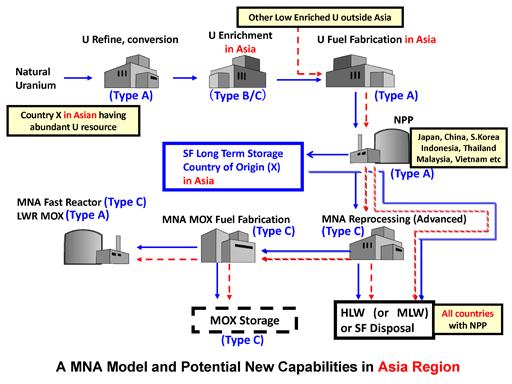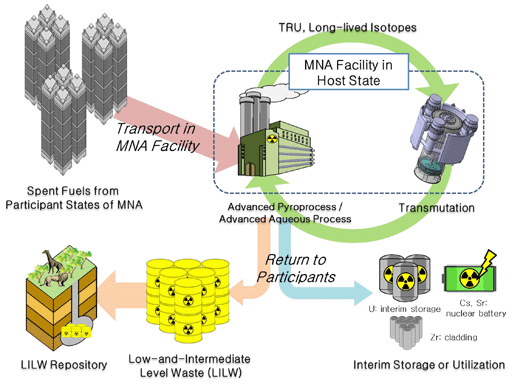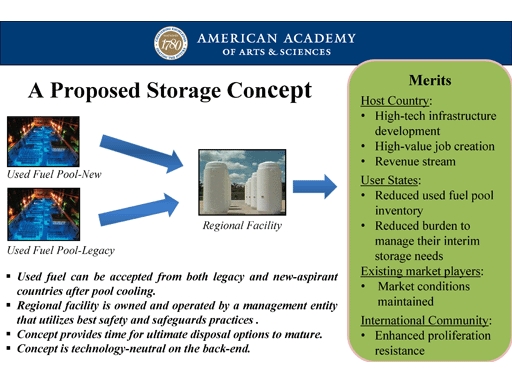International Forum on Nuclear Energy,
Nuclear Non-proliferation and Nuclear Security
- Measures to ensure nuclear non-proliferation and nuclear security for
the back end of nuclear fuel cycle and regional cooperation in Asia -
Opening Remarks
Dr. Atsuyuki SUZUKI, JAEA President
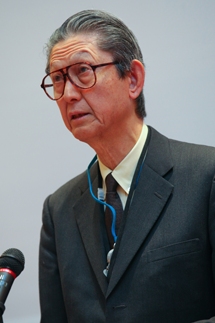 Dr. Atsuyuki SUZUKI
Dr. Atsuyuki SUZUKIIn holding the International Forum on Nuclear Energy, Nuclear Non-proliferation and Nuclear Security, I would like to say a few words of greeting as a representative of the host organization. We are grateful to all of you who have gathered here, especially the experts who kindly participated from various countries, international organizations and domestic organizations as speakers and panelists.
I believe this forum will be a very meaningful and constructive one by receiving various inputs from overseas and domestic participants. This forum is organized annually around the end of the year. Especially this year, we have invited Professor Akito ARIMA as a keynote speaker, who thankfully accepted to make time in his busy schedule. He had led Japan's science and technology policy as President of The University of Tokyo, Minister of Education, Science, Sports and Culture and member of the House of Councilors. Professor Arima is knowledgeable about nuclear energy as an authority on nuclear physics, and has a profound insight into the nature of nuclear energy in terms of science and technology. Today, we expect to hear strict but encouraging words from him about the current status of nuclear energy, as we struggle to learn lessons from the accident at the Fukushima Daiichi Nuclear Power Station (Fukushima nuclear accident) and find the way forward. Other than from Japan, we have invited keynote speakers from the IAEA, the USA, France and the Republic of Korea, who will tell us about changing circumstance s surrounding nuclear energy after the Fukushima nuclear accident.
In the wake of the Fukushima nuclear accident, nuclear safety has been thoroughly enhanced. However, among the so-called "3S," consisting of safety, safeguards and security, the remaining "2S," consisting of safeguards and security, is also essential for proceeding with the use of nuclear energy. In fact, the Nuclear Regulation Authority, newly established in Japan in September 2012 and consisting of Commissioners and the Secretariat, will extend its scope of jurisdiction in April 2013 to become a regulatory organization covering all aspects including nuclear security and safeguards.
In light of the unchanged importance of non-proliferation and security, JAEA intends to continue holding this forum every year to frankly discuss the present challenges and solutions with the aim of building up the social understanding of peaceful use of nuclear energy and non-proliferation and promoting international discussions.
This years' forum focuses on two topics which have international dimensions: one is the back end of the nuclear fuel cycle, and the other is expansion of nuclear power generation in Asia.
While nuclear policies are being reviewed in the wake of the Fukushima nuclear accident, no matter what policies are adopted, the necessity to ensure nuclear non-proliferation and nuclear security does not change. Because the back end of the nuclear fuel cycle is the area to which most attention needs to be paid in this regard, participants are asked to focus on the back end of the nuclear fuel cycle in Panel Discussion 1, which will take place this afternoon.
In Asia, where expansion of nuclear power is expected, it is crucial for the entire region to ensure non-proliferation and nuclear security while proceeding with nuclear power generation. Participants are asked to discuss in Panel Discussion 2, which will take place tomorrow morning, measures to ensure the peaceful use of nuclear energy in Asia and the feasibility of a multilateral cooperative framework involving Japan and other advanced nuclear energy countries, from the viewpoint of supplier states.
All the above themes are challenges that must be resolved in proceeding with the peaceful use of nuclear energy in the world. Although it is impossible to discuss these topics fully in a day or two, I hope we can hear valuable suggestions for considering future directions.
Keynote Speeches
Utilization of Nuclear Energy and Nuclear Non-proliferation in Japan
Prof. Akito ARIMA, Chancellor, Musashi Academy of Nezu Foundation / Former Minister of State for Science and Technology / Former Minister of Education, Science, Sports and Culture
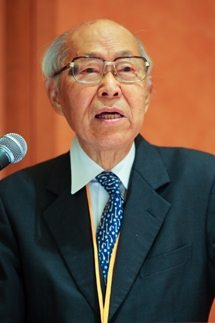 Prof. Akito ARIMA
Prof. Akito ARIMABeing poor in primary energy resources, Japan's self-sufficiency rate in the primary energy supply is only 4%. It is therefore a crucial challenge for this country to ensure energy security. Japan needs to develop renewable energies quickly to prevent the risk of global warming. At the same time, it needs to prepare future plans for the use of nuclear energy while thoroughly establishing safety and fully complying with nuclear non-proliferation requirements.
Although the Fukushima nuclear accident, which occurred in March 11, 2011, impaired the confidence in nuclear energy among the general public, we must decide our energy future calmly on the basis of rational and scientific discussions rather than temporary emotions or populism.
We should conduct more investigation and research on the Fukushima nuclear accident, fully analyze the accident, reflect on the situation, and learn many lessons to plan future measures. With the establishment of the Nuclear Regulation Authority in September 2012, Japan's nuclear regulatory regime is being reformed in terms of (1) separation of nuclear regulation and utilization; (2) unification of regulatory systems; (3) information disclosure with high transparency; (4) transformation of nuclear regulations, including enhanced countermeasures against severe accidents, implementation of nuclear safety regulation based on the latest knowledge and introduction of a 40-year operation limit; and (5) enhancement of the nuclear emergency preparedness system. Japan should implement these reforms vigorously.
As a specialist who has studied nuclear physics for many years and was involved in nuclear energy as Minister of State for Science and Technology, I would like to make some self-reflective remark. In around 1997, when then Prime Minister Hashimoto was carrying out an administrative reform, the Ministry of Education , Science, Sports and Culture, and the Science and Technology Agency were merged to form the Ministry of Education, Culture, Sports, Science and Technology (MEXT). As a result, the priority of nuclear energy was lowered within the MEXT and the promotion and regulation of nuclear energy were not fully separated from each other. These are areas where we could have performed better. We also could have made more strenuous efforts to establish technologies for the back end of the nuclear fuel cycle. It is not too late to promote research and development now on decommissioning, reprocessing, final disposal and other back-end technologies and these should be promoted quickly. The top priority is deciding on the final disposal site of high-level radioactive waste. Another pitfall was overconfidence in the existing countermeasures against tsunamis at nuclear power plants.
We should not forget that Japan has an international responsibility regarding the use of nuclear energy and nuclear non-proliferation. As of the end of 2011, Japan already possessed 9.3 metric tons of plutonium domestically and a total of 35 tons of plutonium in France and the UK. Japan assumes international accountability for the use of the accumulated plutonium. Japan has pursued its nuclear energy programs based on the confidence of the international community in the peaceful nature of such programs. We should be prudent not to act in a manner in which we lose such confidence.
It takes time to develop renewable energies and there is a limit to increasing the percentage share of renewable energies, as evidenced by the German case. We therefore need to continue using nuclear energy. Owing to its long-standing research and development efforts, Japan is among those countries having most advanced nuclear technologies. From an international perspective, it is our responsibility to maintain and strengthen Japan's technological capabilities and human resources.
My recommendations for the future are as follows.
- Japan should play an active role in the fields of decommissioning, accident management, final disposal of high-level radioactive waste, nuclear non-proliferation and nuclear security as well as research and development on next-generation nuclear reactors including fast reactors and nuclear fuel cycle technologies.
- Japan should establish an international nuclear laboratory in the area damaged by the Fukushima nuclear accident to study decommissioning and nuclear safety on an international basis.
- Japan should strengthen the research bases of universities and nuclear research organizations including JAEA.
- Nuclear regulation and its research and development should be pursued in a single entity in terms of the necessity to maintain close coordination
- The role of the Atomic Energy Commission as an entity that discusses nuclear energy policy from the perspective of Japan's long-term energy security should be preserved.
Nuclear Fuel Cycle Back End - Present and Future Safeguards Challenges
Mr. Herman NACKAERTS, Deputy Director General and Head of the Department of Safeguards, International Atomic Energy Agency (IAEA)
(Dr. Peter RANCE of IAEA read the speech on behalf of Mr. Nackaerts)
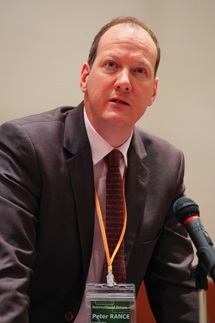 Dr. Peter RANCE
Dr. Peter RANCEThroughout the 1970s and the 1980s the verification of declared nuclear material - generally speaking - seemed to satisfy all parties. However, the discovery in 1991 of a clandestine nuclear weapon program in Iraq provided a stark demonstration that the IAEA needed to enhance its ability to detect possible undeclared nuclear material and activities. The Additional Protocol introduced in response was designed to supplement comprehensive safeguards by providing the Agency with additional information regarding States' nuclear activities and broader access rights. The Agency also introduced a State-level integrated safeguards approach, in which the implementation and evaluation of safeguards look at the State as a whole. Looking at a State as a whole provides the basis for the Agency to strengthen its focus and concentrate its resources on issues of greatest safeguards significance. This shift was a response to the needs for enhanced safeguards and improved effectiveness and efficiency.
Soon after I became Deputy Director General and Head of the Department of Safeguards in September 2010, I initiated a project to ensure the continued evolution and wider application of the State-level approach. This project intends to apply the State-level approach to all States with a safeguards agreement in force, not just those under integrated safeguards. In applying this safeguards approach, the Agency takes into account State-specific factors that are relevant to safeguards implementation. Such factors include the nuclear fuel cycle capabilities of the State, the type of safeguards agreement in force, and the degree of cooperation between the State and the Agency.
In light of the recent change in safeguards approaches, safeguards applied to the back end of the nuclear fuel cycle will also take into account State-specific factors relevant to safeguards implementation.
Most of the IAEA's safeguards experience related to reprocessing has been gained at the two reprocessing plants in Japan. Because reprocessing involves separation of plutonium, which can be diverted to nuclear weapons purposes, its safeguards are more challenging. Nevertheless, various measures have been established to implement safeguards effectively. From a nuclear security perspective, consideration of threat and vulnerability is required in relation to the interim storage of spent fuel, subsequent reprocessing and relevant transport.
The concept of safeguards applicable to spent fuel repositories has already been developed, which will be applied in consideration of the situation of each State. Safeguards measures for spent fuel will continue to be applied during the emplacement and post-closure periods. Since emplaced spent fuel cannot be re-verified, it is important that the measures adopted include sufficient redundancy, diversity and robustness to avoid the possibility of system failure and to ensure continuity of knowledge. Specific safeguards measures include the establishment of knowledge on the disposal site during the pre-construction period, the verification of facility design during the construction period, the verification of transfers and inventory during the operation period, and above-ground monitoring such as visual observation and remote surveillance during the post-closure period.
When a State decides on whether to directly dispose of or reprocess spent fuel, there should be consideration from the perspective of nuclear security. Specifically, it is necessary to assess threats for each option as a basis of physical protection measures for nuclear material in relevant facilities and during transport. In addition, protection systems and measures designed for each facility should be based on an updated threat assessment.
In July 2013, the Agency will be hosting an international conference on nuclear security at the ministerial level. In addition to government ministers, this conference will be attended by regulators, law enforcement officers and practitioners. An important aim of the conference is to be inclusive, not only geographically and in terms of the different types of participants, but also in covering all areas of nuclear security, including those of particular relevance to the back end of the nuclear fuel cycle.
U.S. Approaches to Nuclear Energy and Nuclear Non-proliferation
Mr. Peter HANLON, Assistant Deputy Administrator for Fissile Materials Disposition, Office of Defense Nuclear Nonproliferation, National Nuclear Security Administration (NNSA), U.S. Department of Energy (DOE)
(Mr. Guy LUNSFORD of DOE/NNSA read the speech on behalf of Mr. Hanlon)
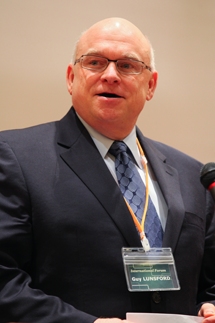 Mr. Guy LUNSFORD
Mr. Guy LUNSFORDAmid the expansion of use of nuclear energy in Asia, one of the primary issues in this region is the back end of the nuclear fuel cycle. One of the primary concerns with the back end is the risk associated with the spread of reprocessing technology and the resulting security concerns associated with the separation of plutonium from spent fuel and ultimate disposition of the material. It is increasingly important that collectively we work to balance concerns associated with nuclear energy, nuclear non-proliferation and nuclear security.
Regardless of the national energy strategy, where nuclear material exists, it is important that we recognize the security risks posed by highly enriched uranium (HEU) and separated plutonium, and assure that the material is safe and secure and has an identified disposition pathway. The United States has been developing methods to dispose of HEU and plutonium generated from dismantled surplus nuclear weapons. Today, I will talk about ongoing cooperation in nuclear non-proliferation between the United States and Japan and efforts being made in the United States to dispose of HEU and plutonium.
The Department of Energy's (DOE) National Nuclear Security Administration (NNSA) has a long and successful history of bilateral cooperation with Japan to ensure that the peaceful use of nuclear energy is pursued in a safe, secure, and properly safeguarded manner. Next year we will celebrate the 25th Anniversary of formal collaboration between the DOE and JAEA including its predecessor organizations on safeguards, nuclear non-proliferation and nuclear security. In January 2011, Japan and the United States formed a new Nuclear Security Working Group, which has achieved notable success in nine areas including JAEA's Integrated Support Center for Nuclear Nonproliferation and Nuclear Security; nuclear forensics; international safeguards implementation; and implementation of IAEA's nuclear security recommendations (INFCIRC/225/Rev.5).
It is important to dispose of HEU and plutonium generated from dismantled surplus nuclear weapons in a safe, secure and irreversible manner. The U.S. industry is down-blending HEU to low enriched uranium (LEU) for use in commercial nuclear reactors in the nation. At the 2011 IAEA General Conference, the United States announced the availability of the American Assured Fuel Supply (AFS). The AFS aims to stockpile approximately 230 metric tons of LEU through down-blending of 17.4 metric tons of HEU generated from dismantled weapons, in order to ensure supply of LEU to emerging nuclear states and obviate their necessity for the development of uranium enrichment technologies.
The United States also works bilaterally with Russia to dispose of HEU and plutonium generated from dismantled surplus nuclear weapons.
In 1993, the United States and Russia concluded the HEU Purchase Agreement1, whose goal is for 500 metric tons of Russian weapons HEU to be down-blended to LEU and sold to the United States by the end of 2013. As of November 2012, 470 metric tons of HEU have been down-blended and the Agreement is on track to reach the 500 metric ton goal by November 2013.
In 2000, the United States and Russia concluded the Plutonium Management and Disposition Agreement (PMDA)2, which commits each country to dispose of at least 34 metric tons of plutonium (corresponding to approximately 17,000 nuclear weapons) in an irreversible and transparent manner. In 2010, on the heels of the first Nuclear Security Summit, both countries signed a Protocol amending the PMDA (amended PMDA). To assure the implementation of disposition in both countries, the United States, Russia and the IAEA are currently negotiating the trilateral agreement for IAEA verification. Key to the amended PMDA was to make it consistent with the Russian nuclear energy strategy including the use of fast reactors. Russia now plans to use their fast reactors, operating under certain non-proliferation conditions, to accomplish plutonium disposition. Under the amended PMDA, Russia commits to (1) operate its fast reactors with a breeding ratio of less than one, resulting in a decrease in the amount of plutonium and (2) not generate any new stockpiles of weapons-grade plutonium. In the United States, on the other hand, plutonium will be fabricated into mixed oxide (MOX) fuel by blending it with depleted uranium at the MOX Fuel Fabrication Facility currently under construction in South Carolina. That fuel will then be sold to utility companies to be used in light water reactors. Despite the differences in the national energy strategies and the types of reactors being used between the United States and Russia, they will achieve disposition of weapons-grade plutonium in a safe, secure and irreversible manner.
It is my hope that this forum will provide new opportunities to expand the dialogue on nuclear energy and nuclear security, as well as leverage expertise in areas dealing with the back end of the nuclear fuel cycle and disposition of HEU and plutonium.
1Agreement Between the Government of the United States of America and the Government of the Russian Federation Concerning the Disposition of Highly Enriched Uranium Extracted from Nuclear Weapons
2Agreement between the Government of the United States of America and the Government of the Russian Federation Concerning the Management and Disposition of Plutonium Designated as No Longer Required for Defense Purposes and Related Cooperation (PMDA)
The New French Administration's Nuclear Energy and Nuclear Non-proliferation Policies
Mr. Frédéric MONDOLONI, Director for International Relations, Strategy and External Relations Sector, French Atomic Energy and Alternative Energies Commission (CEA)
(Mr. Christophe XERRI of the Embassy of France in Japan read the speech on behalf of Mr. Mondoloni.)
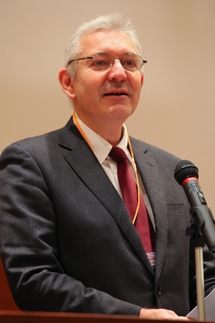 Mr. Christophe XERRI
Mr. Christophe XERRIIn early 2012, Presidential and Parliamentary elections took place in France, resulting in a change of government. Since President Hollande of the Socialist Party formed a new government, there has been no drastic change in the energy and nuclear policy of France.
France is poor in energy resources. Nearly all of our energy needs were imported in the 1970s, and the oil shock had a threatening effect on the French economy. France, in this respect, was in a situation quite similar to Japan. Only nuclear energy could offer the potential to produce electricity in a stable manner in place of oil, and for the sake of energy security and energy independence, the French government decided to make nuclear energy a pillar of electricity production in the country. The French government decided to adopt the U.S.-based pressurized water reactor (PWR) technology. Taking a long-term view, the decision was also made to pursue reprocessing and recycling and to develop the fast reactor. Thanks to the technological standardization and dedication of the French industry, electricity prices in France have become among the lowest in Europe.
In the 2000s, climate change and the need for CO2 reduction began to be taken seriously by European citizens. The European Union (EU) set ambitious goals: reducing CO2 emissions by 20%, increasing energy efficiency by 20% and having a 20% share of renewable energy in the primary energy mix by the year 2020. European countries including France agreed to these binding targets. Even if a new government and a new parliament design a new policy, the European commitment and the basic driving factor of French energy policy will remain the same. Because nuclear energy has a 75% to 80% share in the electricity production of France and is CO2 free and price competitive, any decision on nuclear energy cannot be made lightly.
The Fukushima nuclear accident in March 2011 was a real shock. The French regulator Nuclear Safety Authorities (ASN) swiftly ordered a thorough check of the resistance of all domestic nuclear facilities to external hazards. The same type of "stress test" was launched at the European level. When the ASN declared, early January, that all French nuclear power plants were safe enough to operate, while further strengthening of their safety was necessary, French citizens trusted these conclusions.
In the presidential election campaign after the Fukushima nuclear accident, Francois Hollande, who eventually won the election, pledged to reduce the share of nuclear energy in electricity production from the current level of around 75% to 50% by the middle of the 2020s, while maintaining the recycling policy. The major nuclear energy and nuclear non-proliferation policies of the new administration can be summed up as follows:
- All operating reactors will continue to operate, except for the reactors of Fessenheim which will be shut down by 2016 subject to improvement of the balance of transmission and distribution in the area.
- The on-going construction of a new EPR reactor at Flamanville will continue and the reactor will produce electricity from 2016.
- Reprocessing and recycling are maintained. The La Hague reprocessing plant and the MELOX MOX fabrication plant will continue to operate.
- A national debate on energy transition has been launched. This includes how to reduce the share of nuclear energy to 50% of the gross power generation while abiding with the European commitment and maintaining competitive electricity prices.
- The government maintains a firm will not to reduce the share of nuclear energy to less than 50%. A policy defining the method of energy transition will be issued by the spring of 2013.
- France will continue to export reactors of the highest safety standard, such as the EPR and the ATMEA, developed by the Franco-Japanese joint venture.
- France supports the universal adherence to the IAEA's Additional Protocol and activities of the Nuclear Suppliers Group (NSG).
- France will continue offering enrichment and spent fuel management services, so that countries developing a new nuclear program do not have to develop their own enrichment and reprocessing facilities.
- France will abide by its commitment regarding the Comprehensive Test Ban Treaty (CTBT) and its voluntary decision of not producing any more fissile material for weapons use.
- The new administration will maintain the previous administration's stance in solving the nuclear issues of Iran, North Korea and Syria.
France has been cooperating with Japan in the field of nuclear energy for nearly 50 years. There is still some Japanese plutonium in France. We are reassured that the current Japanese nuclear policy is consistent with its commitment with France. We expect that all plutonium will be manufactured into MOX fuel in France and be loaded in Japanese nuclear power plants. More broadly, I hope that the recent decisions of the Japanese government would not hinder our cooperation in nuclear energy use and nuclear non-proliferation. Nuclear energy will remain an important pillar of energy supply. As countries that already have an established infrastructure and a strong experience, Japan and France have a duty to support emerging nuclear states towards the safe and peaceful use of nuclear energy.
Korea's Perspective: Nuclear Energy, Nonproliferation and Safety
Mr. Ro-byug PARK, Ambassador for Energy & Resources, Ministry of Foreign Affairs and Trade (MOFAT), Republic of Korea
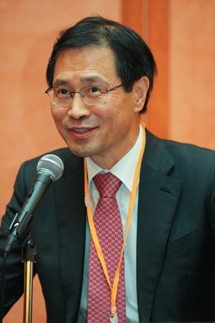 Mr. Ro-byug PARK
Mr. Ro-byug PARKI. The ROK's energy policy and nuclear energy development
The Republic of Korea (ROK) is the world's third largest energy-importing country after the United States and Japan. The ROK imports about 97% of its consumed energy, which amounts to about 171 billion dollars annually. The national energy plans call for reducing the nation's dependency on fossil fuel and increasing the share of nuclear and renewable energy up to about 40% by 2030. Because the development of renewable energy requires considerable time and money, the highest priority is given to nuclear energy in the short term.
II. Nuclear power development in the ROK
The ROK's nuclear R&D and industry activities have grown by leaps and bounds over the past four decades. We now have 23 nuclear power plant units in operation. On the basis of Westinghouse's technology, the ROK has successfully developed and standardized domestic reactors such as OPR1000 and APR 1400. In order to attain energy security, the ROK is trying to improve its nuclear fuel cycle back end capability. The ROK hopes that a new nuclear cooperation agreement with the United States will help it achieve this goal while promoting international nuclear non-proliferation and ensuring continued economic growth.
III. The ROK's non-proliferation commitments
The ROK is completely committed not to abuse the right for the peaceful use of nuclear energy for the manufacture of nuclear weapons. Its firm stance on nuclear non-proliferation is essential for the ultimate abandonment of North Korea's nuclear weapons programs. While the ROK has taken all legal measures for non-proliferation, it requires political commitments in addition to legal and technical measures to achieve nuclear non-proliferation. Both Japan and the ROK need to maintain trust and security alliance with the United States.
The ROK established the Korea Institute of Nuclear Non-proliferation and Control (KINAC) in 2006 and the Nuclear Safety and Security Commission (NSSC) in 2011.
IV. Nuclear safety and challenges for the ROK and Japan
Since the Fukushima nuclear accident in March 2011, nuclear safety has become a top priority for every nuclear-powered country. The ROK's nuclear plant operators have taken various safety measures against seismic disasters, although the chances of a large-scale earthquake occurring in the ROK are very low. Japan's forthcoming Parliamentary elections and the ROK's upcoming Presidential election are likely to have an important impact on both countries' future policies on nuclear energy. Regardless of the results of the elections, both countries share three challenges: restoration of public trust in nuclear safety, management of existing spent fuel, and coping with an emerging regional landscape in nuclear power in Asia with the rise of China, etc.
V. The ROK-Japan Collaboration in Nuclear Energy
The ROK and Japan can collaborate on the R&D of nuclear energy in the following five areas: (1) nuclear safety enhancement; (2) the nuclear fuel cycle back end and relevant reactors; (3) geologic disposal technology development; (4) global nuclear safeguards and security enhancement; and (5) decommissioning. From a broad regional perspective, we must cooperate in maintaining high safety standards in reactors in China. We also need to consider multilateral cooperation frameworks. Although the top officials of Japan, China and the ROK have already started to discuss nuclear accident prevention, more extensive discussions would be required.
Summary
We now need to restore public trust in nuclear energy. This is a very important issue, and Japan and the ROK can cooperate in areas such as energy security and sustainable energy. I hope this forum will generate various ideas and open up new avenues for the future.
Panel Discussion 1
"Measures to ensure nuclear non-proliferation and nuclear security of nuclear fuel cycle back end"
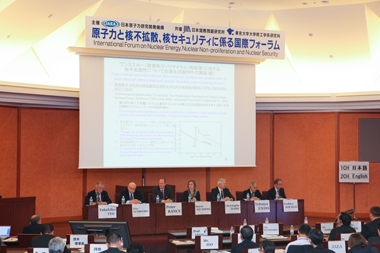
- Chairperson
- Mr. Takahiko ITO, President, Japan Atomic Energy Relations Organization / President, Institute of Nuclear Materials Management (INMM), Japan Chapter / Advisor of Chubu Electric Power Co., Inc.
- Panelists
- Ambassador Tetsuya ENDO, Chair of the Taskforce, the Japan Institute of International Affairs (JIIA)
- Mr. Guy LUNSFORD, Director, International Programs Office, Office of Fissile Materials Disposition, National Nuclear Security Administration (NNSA), U.S. Department of Energy (DOE)
- Mr. Toshiro MOCHIJI, Director, Department of Science and Technology for Nuclear Material Management (STNM), JAEA
- Dr. Peter RANCE, Section Head, Coordination and Support Section, Division of Operations A, Department of Safeguards, IAEA
- Ms. Sharon SQUASSONI, Director and Senior Fellow, Proliferation Prevention Program, Center for Strategic and International Studies (CSIS)
- Mr. Christophe XERRI, Nuclear Counsellor at the Embassy of France in Japan
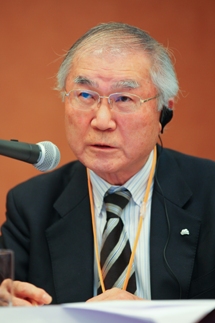 Mr. Takahiko ITO
Mr. Takahiko ITODiscussion Point
Discuss challenges in ensuring nuclear non-proliferation and nuclear security of the nuclear fuel cycle back end and possible measures to overcome such challenges
- Nuclear non-proliferation and nuclear security challenges associated with for each option of reprocessing and direct disposal of spent nuclear fuel and possible measures to overcome such challenges
- Nuclear non-proliferation and nuclear security challenges in the context of the current Japanese nuclear landscape and possible measures to overcome such challenges
- Responding to the concerns about an increasing separated plutonium inventory caused by continuation of reprocessing and the decreased number of operating nuclear reactors
- Measures to ensure safeguards and nuclear security for the research and development of direct disposal of spent nuclear fuel on a long-term basis
- Measures to dispose of Japan's plutonium temporarily stored abroad
Outline of Panel Discussion 1
In Panel Discussion 1, the panelists discussed the nuclear non-proliferation and nuclear security at the back end of the nuclear fuel cycle in consideration of Japan's nuclear policy. First, they discussed, in general terms, challenges in ensuring nuclear non-proliferation and nuclear security as well as measures to overcome such challenges for each of the two options: reprocessing and direct disposal of spent fuel. Because the direct disposal of spent fuel does not involve plutonium extraction, it is generally perceived to have a lower risk of nuclear proliferation than reprocessing. In this panel discussion, some panelists pointed out that the radioactivity of spent fuel decreases with the passage of hundreds of years after the closure of the disposal site, so that the plutonium in the spent fuel becomes more accessible; this is a so-called "plutonium mine" issue. They therefore indicated the necessity of the consideration of safeguards approaches and application of nuclear security measures also for direct disposal. In terms of nuclear non-proliferation and security, the concept of retrievability being discussed in the field of geological disposal has a drawback to keep spent fuel accessible for a long time period. It was suggested that specialists in the field of geological disposal and the specialists in the field of nuclear non-proliferation and nuclear security discuss talk with each other from a perspective of social science, considering the ethical adequacy of leaving a burden to future generations. As regards spent fuel reprocessing, some panelists pointed out difficulties in detection associated with handling plutonium in a solution, whereas others argued that an effective application of safeguards had already been demonstrated in Japanese reprocessing plants.
Next, Japan's nuclear policy was discussed from the viewpoint of nuclear non-proliferation and nuclear security, in particular inconsistency between the continuation of reprocessing and the phase-out from nuclear power generation by the 2030swhich are noted in the Innovative Strategy for Energy and the Environment issued on September 14, 2012 by the Energy and Environment Council. Japanese participants argued that Japan should maintain the nuclear fuel cycle from the viewpoint of energy security and made following suggestions in order to resolve non-proliferation concerns over plutonium stockpiles.
- As a short-term measure, plutonium should be irradiated in light water reactors
- As a mid-term measure, plutonium should be irradiated in fast reactors
- As a long-term measure, plutonium use should be conducted in the multilateral approach of nuclear fuel cycle
While overseas participants appreciated Japan's commitments to non-proliferation so far, they pointed out the necessity and importance of following Japan's actions in order to continue reprocessing;
- Promoting the use of plutonium in light water reactors and fast reactors so as to mitigate domestic and overseas concerns over plutonium stockpiled without usage plans,
- Explaining the nation's plans for plutonium use transparently to people in Japan and abroad,
- Preparing backup plans in case the plans for plutonium use do not progress as intended.
The participants presented the following discussions for each Discussion Point.
[Discussion Point 1: Nuclear non-proliferation and nuclear security risks associated with reprocessing and direct disposal of spent nuclear fuel]
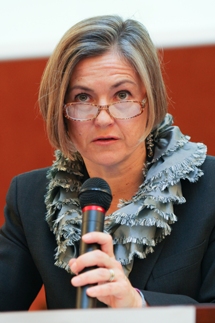 Ms. Sharon SQUASSONI
Ms. Sharon SQUASSONI- Mr. ITO, the chairperson, introduced past discussions relevant to Discussion Point 1, including those of the International Nuclear Fuel Cycle Evaluation (INFCE), the Technological Opportunities to Increase the Proliferation Resistance of Global Civilian Nuclear Power Systems (TOPS), the Advanced Fuel Cycle Initiative (AFCI), and the development of the Framework for Nuclear Energy Policy in Japan in 2004 and 2005. These discussions concluded that there was no significant difference in the proliferation resistance between the reprocessing option and the once-through option on a long-term basis.
- Ms. SQUASSONI presented a perspective view in the U.S., but not a U.S. government's view, of nuclear non-proliferation and nuclear security regarding both reprocessing and direct disposal of spent fuel. Plutonium represents the greatest risk, and the risk of proliferation and security threat depends on the form of plutonium. In assessing proliferation risks, attractiveness in terms of diversion to weapons and the ease of detection are important elements. Direct disposal is generally viewed by the non-proliferation community as the most proliferation-resistant approach. Beyond 100 years, however, the radiation level decreases so that the spent fuel becomes more accessible. This is what is referred to as a "plutonium mine." On the other hand, the reprocessing option involves so-called bulk handling facilities, such as reprocessing plants and MOX fuel fabrication plants, in which diversion of a small amount of nuclear material is difficult to detect.
Question 1: Nuclear non-proliferation and nuclear security challenges associated with direct disposal, compared with reprocessing of spent fuel
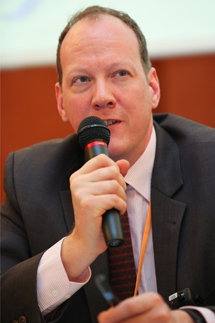 Dr. Peter RANCE
Dr. Peter RANCE- Dr. RANCE described challenges related to safeguards in the back end. The IAEA is applying its safeguards to facilities related to each option of the direct disposal and reprocessing (namely, spent fuel storage facilities and reprocessing facilities). The Agency has already developed approaches for the application of safeguards to a spent fuel repository and plans to start the application in the near future. In the case of direct disposal, safeguards do not terminate when material is disposed of, but rather, it will continue indefinitely on that material as long as the safeguards agreements continue to exist. Plutonium separated by reprocessing can be measured directly, although there is a need to measure a small amount of nuclear material precisely. In the case of direct disposal, plutonium in the spent fuel must be verified by indirect means. Nevertheless, the two options have commonality in safeguards objectives and generic safeguards measures (such as taking the facility design into account and grasping the amount of nuclear material). The State-level approach means consideration of state-specific factors in applying safeguards. This means when applying the State-level approach, for example, to the safeguards of repositories, the method of applying safeguards may depend on whether the State has reprocessing facilities or not.
- Mr. MOCHIJI described potential nuclear proliferation risks which would be imposed on future generations due to the fact that accessibility to nuclear material increases over time. Because of the decrease of the radioactivity of fission products in the spent fuel directly disposed of, it becomes easier to access the large amount of plutonium left in the spent fuel, 100 years to tens of thousands of years after disposal. We therefore need to develop new safeguards approaches. The interaction between geological disposal specialists and nuclear non-proliferation/security specialists has not been active so far, however, such interaction is becoming increasingly important. It is necessary to discuss from a perspective of social science such themes as the ethical adequacy of leaving a burden to future generations.
Question 2: Views on challenges on direct disposal of spent fuel
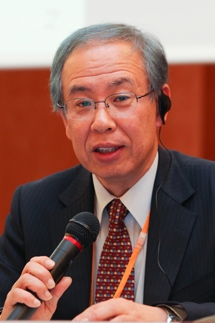 Mr. Toshiro MOCHIJI
Mr. Toshiro MOCHIJI- Mr. MOCHIJI described the approach to disposal of high-level radioactive waste (including spent fuel) that the Science Council of Japan recommended to the Atomic Energy Commission in September 2012. The Council said that a thorough review of the existing disposal policy on the basis of a national consensus is necessary, and recommended establishing an administrative framework centering on temporary storage over tens to hundreds of years and the control of total amount. The concept of temporary storage is to store spent fuel in a deep formation or on the ground while maintaining retrievability. It is different from interim storage in a way that it does not have a predetermined method of treatment after the storage and it allows selection at some future time. In response to the recommendation, the Atomic Energy Commission issued a draft policy in November but left the adoption of temporary storage to be discussed at a later time. Retrievability and reversibility are also assumed in other states, such as the United States, France and Switzerland. In Japan, retrievability shall be maintained until the adequacy of the disposal method is confirmed by safety assessment at the time of repository closure.
- Mr. LUNSFORD described the U.S. approaches to the disposition of plutonium derived from dismantled nuclear weapons. At the end of the Cold War, the United States began to consider how to eliminate about 60 metric tons of excess plutonium generated by the dismantlement of nuclear weapons. The Department of Energy asked the National Academy of Science to evaluate a number of disposition options. The Academy suggested three broad categories: immobilization, deep borehole disposal and irradiation in reactors as MOX fuel. As a result of an investigation by National Laboratories, the deep borehole disposal option was eliminated, and the dual-track approach consisting of irradiation in reactors and immobilization was adopted. Further investigation resulted in eliminating the immobilization option, which does not change the isotopic composition of the plutonium, and making a decision to pursue the MOX option only. A MOX fuel fabrication facility is under construction based on AREVA's design. After being irradiated in a reactor, spent MOX fuel will be stored without reprocessing subject to the IAEA's verification. For countries having energy strategies including spent fuel recycling, it is important to have concrete plans to use plutonium separated by reprocessing. The United States is ready to cooperate with such countries making use of the expertise in the field of the disposition of plutonium.
Question 3: Challenges and countermeasures regarding nuclear non-proliferation and nuclear security in the case of reprocessing
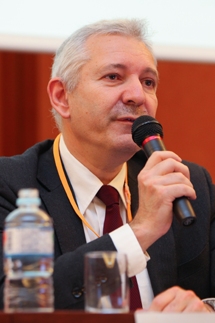 Mr. Christophe XERRI
Mr. Christophe XERRI- Mr. XERRI: In France, we consider plutonium to be an asset to be recycled to produce electricity. From the viewpoint of nuclear non-proliferation, France has a policy to reuse reprocessed plutonium as soon as possible. It is possible to apply safeguards effectively to large-scale reprocessing plants and MOX fuel fabrication plants.
- Ambassador ENDO: Japan recognizes plutonium as a resource. As a non-nuclear-weapon state, Japan calls for clarifying when and where plutonium will be used at the time of plutonium separation in accordance with the policy to "have no surplus plutonium, namely, plutonium without plans for use", as decided by the Atomic Energy Commission.
- Dr. RANCE: Regarding the application of safeguards to reprocessing facilities, it is said that there arises difficulty in monitoring after spent fuel is dissolved to be transformed into a solution. In Japan, however, safeguards have been successfully applied to the Tokai Reprocessing Plant since the 1970s and it is demonstrated that safeguards can be applicable to the Rokkasho Reprocessing Plant, which is a much larger facility with such accuracy that it is possible to detect 0.1% of the plutonium annually generated. It is also important to ensure that we can accurately account for the plutonium inventory in a way that does not interfere significantly with the commercial operation of a reprocessing plant.
[Discussion Point 2: Nuclear non-proliferation and nuclear security challenges in the context of the current Japanese nuclear landscape]
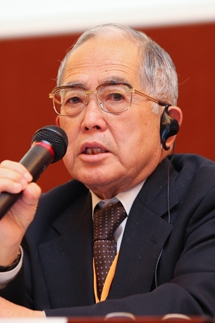 Ambassador Tetsuya ENDO
Ambassador Tetsuya ENDO- Mr. MOCHIJI outlined the Innovative Strategy for Energy and the Environment issued on September 14, 2012 by the Energy and Environment Council, which presented three pillars. 1)Realization of a society that does not depend on nuclear power at the earliest possible date 2) Realization of a green energy revolution 3) Stable energy supply
He also presented domestic and overseas reactions to the Strategy's statement of phasing out nuclear power generation (no operating nuclear plants in the 2030s) while proceeding with reprocessing.
Question 1: Significance of maintaining the nuclear fuel cycle option in Japan
- Ambassador ENDO: Since the early days of nuclear development, Japan has been adopting the nuclear fuel cycle option for the efficient use of uranium, which is a finite resource. When the supply of uranium was tight, even the United States, which currently adopts the once-through option, had a policy of not supplying uranium to Japan if Japan does not proceed with the nuclear fuel cycle. Against this backdrop, Japan should maintain the nuclear fuel cycle option. The Strategy of the Energy and Environment Council calls for decreasing reliance on nuclear power while maintaining reprocessing, but does not show how to use separated plutonium that already exists in Japan and abroad as well as separated plutonium that will be generated by reprocessing. Because of such problems, it is understandable that the Strategy has raised concerns from overseas countries.
Question 2: Perspective of panelists from other states on Japan's keeping the option of closed nuclear fuel cycle; views on Japan as a model country pursuing peaceful use of nuclear energy while ensuring nuclear non-proliferation
Question 3: Responses to international concerns over accumulated plutonium
Question 4: Measures to deal with Japan's plutonium temporarily stored abroad
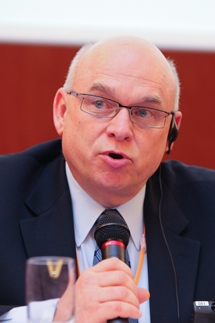 Mr. Guy LUNSFORD
Mr. Guy LUNSFORD- Mr. XERRI: France believes that Japan is seriously committed not only to non-proliferation within the country but also to strict export control. Japan has been taking leading roles in the implementation of IAEA safeguards, such as the implementation of Additional Protocol and integrated safeguards as well as the application of safeguards to domestic nuclear fuel cycle facilities. It is undesirable to have plutonium accumulated without a defined policy for use. Japanese utilities have completed contracts for MOX fabrication of plutonium in France, and MOX fuel has already been loaded into three Japanese reactors. Because the Japanese nuclear policy states that reactors whose safety is confirmed will resume operation, we expect that the plutonium stored in the UK and France and the plutonium separated at the Rokkasho reprocessing plant will be burned in Japanese light water reactors including the Ohma unit. It is possible that plutonium will be burned also in light water reactors other than those reactors in which MOX use is currently planned. The use of MOX fuel in light water reactors is a transitional approach until fast reactors become available. Plutonium will be burned more efficiently in fast reactors, which can also serve as burner reactors. We need to take a long-term view in this regard.
- Mr. LUNSFORD: The United States is impressed with Japan's commitment to IAEA safeguards. Next year, the Department of Energy and JAEA will celebrate the anniversary of 25 years of cooperation on safeguards and other nuclear non-proliferation areas . Our most recent collaboration includes participation in the U.S.-Japan Nuclear Security Working Group and co-organization of a training course in the Integrated Support Center for Nuclear Non-proliferation and Nuclear Security. The United States respect Japan as a model country conducting peaceful use of nuclear energy and making due non-proliferation and security efforts.
- Ms. SQUASSONI agreed with the comments about Japan as a model nuclear non-proliferation partner. However, it is difficult to continue reprocessing with no clear future for nuclear power in Japan. Then she made following four comments;
- A plan dealing with the plutonium stockpiles requires transparency
- Japan needs to do a better job on explaining the domestic pressures for reprocessing including agreements with local communities to the rest of the world.
- It is necessary to prepare a backup plan on how to dispose of plutonium. Although the idea of burning plutonium in fast reactors is useful, it is not going to happen for a while. Japan, therefore, need to move forward with a phased approach
- The idea of using the Rokkasho Reprocessing Plant as a multilateral facility is probably not so practical in terms of its reprocessing capacity and the unwillingness of other countries to send their spent fuel.
- Ambassador ENDO: What is effective as a short-term measure is increasing the number of light water reactors that burn plutonium while overcoming local opposition, and in the medium term introducing fast reactors is important. Fortunately, the Innovative Strategy for Energy and the Environment states nothing about the future of fast reactors after the termination of the Monju reactor research project. I interpret this as not ruling out the possibility of introducing fast reactors in the future. In the long term, multilateral approach of the nuclear fuel cycle should be discussed. The aforementioned plutonium burning strategies should be formulated as a grand design.
- Mr. MOCHIJI: Plutonium is a valuable domestic energy resource for Japan, whose self-sufficiency rate of energy is low. In addition to burning plutonium as MOX fuel in light water reactors, we need to discuss various plutonium use options such as use of MOX fuel in fast reactors including plutonium burner reactors, and multilateral cooperation in the nuclear fuel cycle from a long-term perspective. In any case we need to explain the measures for the use of plutonium stockpiles to the international community transparently and clearly.
[Question-and-answer session involving the audience]
- Question 1: France states that it promotes nuclear energy for the reduction of CO2 emissions and suppression of electricity rates. France is highly dependent on nuclear power in spite of the existence of the renewable energy option to reduce CO2 emissions. Is this because France gives higher priority to economy than safety?
- Mr. XERRI: As with Japan, France is promoting energy efficiency and energy conservation. Both countries are cooperating in this regard. France is also promoting the development of renewable energies including wind and biomass energies. I belong to what was called the "Atomic Energy Commission" and is now called the "Atomic Energy and Alternative Energies Commission", so we are very clear about the promotion of renewable energies in addition to nuclear energy. Since we have 58 nuclear power reactors in the country, safety cannot be anything but first priority. We have a safety authority that is independent, transparent and very strong in technical capabilities and are striving to introduce best practices. After obtaining the result of stress tests, the safety authority of France instructed the spending of 10 or 30 billion Euros for safety improvements while allowing the reactors to continue operation. This clearly indicates the principle of safety first. We are always making improvements with the understanding that all technologies have risks and there is no perfect technology.
- Ms. SQUASSONI: Japan is not the only country struggling with this issue. Views on nuclear energy tend to be controversial. We have to remember that nuclear energy is a business, not a religion. Because the business involves sunk cost, we need to do things deliberately. Not only private entities but also governments should play important roles. All nuclear power states including Japan have waste, safety and other issues in common. So I would encourage a rational and not an emotional discussion of these issues. And for that we need a lot of transparency on both sides.
- Question 2: With a change in policy, how should Japan contribute to international society regarding non-proliferation?
- Mr. XERRI: Japan has contributed significantly to the international framework of nuclear non-proliferation. There is fear that Japan's influence on nuclear non-proliferation might decrease due to the recent policy change. Japan should contribute internationally with its knowledge and human resources in the field of nuclear non-proliferation.
- Ms. SQUASSONI: International contributions to non-proliferation include export control as well as diplomatic and financial measures. Japan should retain its technological expertise and other current assets, and seek measures adaptable to the new strategy. Japan remains an important nuclear non-proliferation partner.
- Ambassador ENDO: Japan should promote the 3S initiative globally as a basic concept that has been proposed since the G8 Hokkaido Toyako Summit.
- Mr. LUNSFORD: Japan has been contributing to nuclear non-proliferation from a unique perspective, and I hope that will continue. Recently, there was a break-in at the Y-12 plant of the United States. Rather than shutting down the facility, NNSA Administrator D'Agostino ordered safety and security improvements by learning from the incident. In the case of the Fukushima nuclear accident, it is also important to make use of lessons learned globally. Making improvements to processes will lead to preventing another accident that might be even worse in the future. I hope Japan will allow the United States to continue working together to learn from the accident and improve safety, rather than abandoning nuclear power.
- Dr. RANCE: Japan has very strong nuclear non-proliferation credentials historically because of its openness in explaining its nuclear energy policies. While Japan's current nuclear policy appears to be in confusion, the country should send a clear explanation to the world as soon as possible. The advantage of the MOX fuel use in light water reactors is the capability to reduce plutonium stockpiles, and it is important to reassure people by explaining in detail how the project can achieve its objective.
- Comment 1: The 3S initiative, proposed by Japan, was reflected in the Hokkaido Toyako Summit documents. This initiative was initially not accepted by non-aligned movement (NAM) states, and it was later agreed by the NAM states at the 2010 NPT Review Conference. This demonstrates that there are some areas in which Japan can contribute to international rulemaking. Japan has been supporting IAEA safeguards, and it should continue to cooperate technically with the IAEA in particular in the field of "safeguards by design".
- Question 3: There are gaps of the views between geological disposal researchers and safeguards specialists. From the viewpoint of geological disposal, it is a prevailing idea in the world to keep material retrievable during the first 100 years or so. From the viewpoint of safeguards, radiation levels and heat generation are reduced after 100 years, so that the material disposed of becomes more accessible and the issue of nuclear proliferation arises. Are there international discussions going on between the two groups?
- Dr. RANCE: Discussions on the concept of long-term safeguards applicable to repositories are still at a beginning stage. A generic concept has already been developed, and currently being discussed is what elements should be included in the safeguards approaches. The approaches will continue to evolve and improve. I think we can apply sufficiently rigorous safeguards to repositories to ensure that any attempts to retrieve spent fuel for diversion to nuclear weapons would be prevented.
- Question 4: When weapons-grade plutonium is burned as MOX fuel in order to dispose of plutonium from nuclear weapons, new plutonium is generated from uranium in the reactor. So the net amount of plutonium may not be reduced through the process. Does the benefit of burning plutonium in a reactor lie in changing the isotopic composition or mixing with spent fuel?
- Mr. LUNSFORD: Weapons-grade plutonium contains plutonium-239 at a content greater than 90%. This is reduced to about 50% by burning the plutonium in a reactor. There is also a significant non-proliferation advantage of confining plutonium in spent fuel.
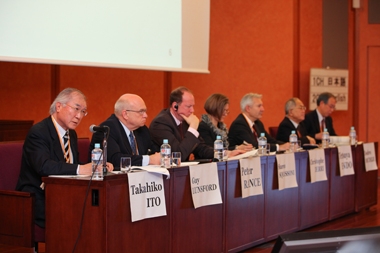
Panel Discussion 2
"Measures to ensure nuclear non-proliferation and nuclear security for nuclear energy use in the Asian region and a multilateral cooperative framework"
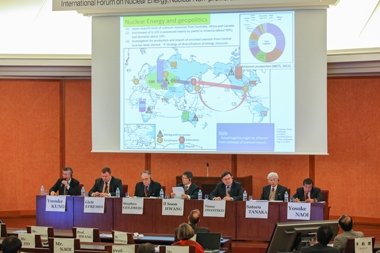
- Chairperson
- Dr. Yusuke KUNO, Deputy Director, JAEA/STNM
- Panelists
- Mr. Gleb EFREMOV, Commercial Director, JSC International Uranium Enrichment Center (IUEC), Russia
- Mr. Stephen GOLDBERG, Research Coordinator, Global Nuclear Future Project, American Academy of Arts and Sciences
- Prof. Il Soon HWANG, The Seoul National University College of Engineering, Republic of Korea
- Mr. Yosuke NAOI, Deputy Director, Integrated Support Center for Nuclear Nonproliferation and Nuclear Security (ISCN), JAEA
- Prof. Satoru TANAKA, Professor, Department of Nuclear Engineering and Management, School of Engineering, The University of Tokyo
- Dr. Timur ZHANTIKIN, Chairman of the Agency for Atomic Energy, Republic of Kazakhstan
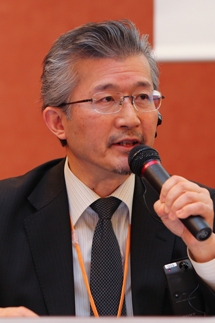 Dr. Yusuke KUNO
Dr. Yusuke KUNODiscussion Point
From the supplier states' perspectives, the following points will be discussed in the context of reducing the risk of nuclear proliferation and terrorism associated with the expansion of nuclear energy use in the Asian region.
- Current status and future prospects of nuclear power generation in the Asian region, including challenges associated with the nuclear fuel cycle back end
- Nuclear supplier states' nuclear export polices-Requirements applicable to the export of nuclear equipment and material for recipient states from nuclear non-proliferation and nuclear security viewpoints
- Efforts by supplier states to help newcomer states in ensuring nuclear safeguards and nuclear security
- Feasibility of establishing a multilateral nuclear approach (MNA)-A regional framework ensuring "3S" (safety, safeguards and security), merits and demerits for supplier and recipient states, and incentives for participation in such a framework
Outline of Panel Discussion 2
In Asia, newcomer states are planning to introduce nuclear power and existing nuclear power states are continuing the construction of additional reactors even after the Fukushima nuclear accident. In addition to the conventional supply route of nuclear fuel from Western countries, there is an emerging flow of nuclear fuel supplied from Central Asia including Russia and Kazakhstan to East Asian states. In this Panel Discussion, the panelists discussed measures to ensure nuclear non-proliferation and nuclear security in the use of nuclear energy in Asia. One of such measures is a multilateral nuclear approach (MNA) of nuclear fuel cycle facilities. The panelists discussed the implication of such approaches and challenges associated with the implementation of the approaches.
To ensure nuclear non-proliferation and nuclear security, The Western nuclear suppliers have been taking so-called supply-side approaches, in which supplier states impose requirements on recipient states by means of export control and bilateral nuclear cooperation agreements. Given that supplier states have been diversified, some panelists argued that there were limitations to the supply-side approaches, which embraced a sharp distinction between "haves" and "have-nots". They pointed out the importance of demand-side approaches, in which recipients states were given incentives to refrain from pursuing sensitive technologies. One of the demand-side approaches is to operate nuclear fuel cycle facilities internationally to provide front-end and back-end services, so that recipient states and participating states are motivated to refrain from developing sensitive technologies. Various studies have already been conducted on this type of approach, which is called an MNA. Some panelists explained their proposed MNAs applicable to the back end; these panelists are Prof. Tanaka representing a research group of The University of Tokyo, Prof. Hwang of The Seoul National University, and Mr. Goldberg representing the Global Nuclear Future Project of the American Academy of Arts and Sciences. Some panelists said that MNAs on the back end would potentially contribute to enhancing the regional framework of "3S" (safety, safeguards and security), and to this end, suggested the importance of motivating participants, building up trust between participating states, and maintaining the flexibility to incorporate technology development in the future. On the other hand, some panelists said that there were many challenges to be addressed because of the involvement of many states; such challenges include creating incentives to participate in the MNA, ensuring public acceptance, securing host countries, financing the MNA, arranging nuclear material transport, and maintaining consistency in the policies of participating states. One of the panelists proposed studying the feasibility of MNAs by launching an Asia Pacific task force.
The participants presented the following discussions for each Discussion Point.
[Discussion Point 1: Nuclear energy use in Asia - Challenges associated with the back end]
- Dr. KUNO, chairperson of the panel, made the following explanation as an introduction to Discussion Point 1.
- The existing international efforts for nuclear non-proliferation and nuclear security include both supply-side and demand-side approaches. In the supply-side approaches, nuclear supplier states impose non-proliferation requirements on recipient states on the basis of the NSG guidelines and bilateral nuclear cooperation agreements, so as to maintain and enhance measures that restrict the possession of sensitive technologies and facilities by recipient states. In the demand-side approaches, the incentive for recipient states to possess sensitive technologies and facilities is decreased, for example, by ensuring the supply of nuclear fuel and services and introducing a multilateral nuclear approach (MNA) to the nuclear fuel cycle.
- The recent circumstances of nuclear energy show that in Asia, newcomer states are planning to introduce nuclear power and existing nuclear states are constructing additional reactors actively even after the Fukushima nuclear accident. In addition to Australia and Canada as conventional suppliers, Kazakhstan has emerged as a new supplier of natural uranium in Central Asia, and Russia has started to stockpile low enriched uranium with its abundant uranium enrichment capability. These two movements show a shift from the conventional supply route of nuclear fuel from Western countries to the emerging route from Russia and Kazakhstan.
- Japan, the Republic of Korea and Taiwan are facing the issue of accumulated spent fuel handling, which requires swift countermeasures.
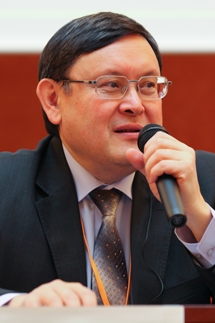 Dr. Timur ZHANTIKIN
Dr. Timur ZHANTIKIN- Dr. ZHANTIKIN: Kazakhstan now cooperates with ROSATOM, AREVA and other partners to acquire fuel fabrication technologies and develop relevant businesses in order to fabricate various types of nuclear fuel applicable to different reactor types. If a nuclear network is created in Asia, Kazakhstan will be able to ensure uninterrupted supply of nuclear fuel for a long period of time. Being situated inland of the Asian Continent, Kazakhstan has to rely on ground transportation.
Regarding nuclear export control, Kazakhstan complies with the NSG guidelines and asks recipient states to participate in the NPT (with an exception of one state3), maintain a state system of accounting for and control of nuclear material, ensure the peaceful use of nuclear energy, maintain the IAEA safeguards, and implement physical protection in accordance with the IAEA recommendations.
The International Uranium Enrichment Center (IUEC) in Russia and the IAEA nuclear fuel bank to be established in Kazakhstan may become MNA model cases.
- Mr. EFREMOV: The state-owned Russian nuclear firm ROSATOM is engaged in a wide range of front-end businesses including uranium mining and reactor construction both in and outside Russia, and is proceeding with a project of fuel fabrication and reprocessing conducted at a reactor site with a focus on the BN-1200 first breeder reactor, which has a popular name meaning "breakthrough." With the increasing use of nuclear energy in Asia, company TENEX is creating a new route of transporting nuclear material to Asian areas through Vostochny in the eastern part of Russia.
Russia has a policy of recycling spent fuel as regards the back end of the nuclear fuel cycle.
In controlling the export of sensitive nuclear technologies to non-nuclear weapons states, Russia requires the recipient country to comply with the requirements in addition to the requirements applicable to the export of non-sensitive nuclear equipment and material. Those requirements include participation in the NPT and observance of the NPT guidelines, adherence to the Additional Protocol to IAEA safeguards, absence of non-compliance with the IAEA safeguards agreement, compliance with the NSG guidelines, submission of reports in accordance with the United Nations Security Council Resolution 1540, compliance with the IAEA recommendations and other international rules related to nuclear safety, prohibition of the replication or improvement of sensitive technologies, and accept the inspection by the Russian Federation on safety and safeguards in the recipient state.
3India
Question 1: Concerns and challenges associated with nuclear non-proliferation and nuclear security in view of the expanding use of nuclear energy in Asia
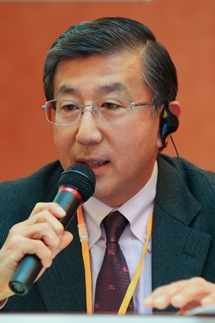 Mr. Yosuke NAOI
Mr. Yosuke NAOI- Mr. NAOI: In Asia, we need to make a distinction between states that are newly introducing nuclear power and existing nuclear powered states. The states which belong to the former category should nurture non-proliferation and security cultures in addition to nuclear safety cultures. The advanced nuclear power states such as Japan, the Republic of Korea and Taiwan faces the challenge of ensuring nuclear security associated with the accumulation of spent fuel.
As regards export control, control by supplier states through bilateral nuclear cooperation agreements is more important than multilateral frameworks. It is necessary for all supplier states to maintain common levels of export control criteria.
Question 2: Effectiveness and limitation of supply-side approaches for ensuring nuclear non-proliferation and nuclear security, including nuclear export controls and bilateral nuclear cooperation agreements
- Prof. TANAKA: Proliferation of sensitive technologies has been prevented by supply-side approaches led by nuclear supplier states, which mainly are Western states. Because of the recent shift of the nuclear fuel supply scheme to involve supply from Central Asia to East Asia, it is unclear if we can still ensure nuclear non-proliferation by the conventional approaches. There are limitations to the supply-side approaches, which embrace a sharp distinction between states that "have" and "do not have" sensitive technologies and facilities. As a new demand-side approach to ensure nuclear non-proliferation while promoting the peaceful use of nuclear energy, I suggest exploring multilateral nuclear approaches in which a nuclear fuel cycle facility is managed multilaterally.
The NSG guidelines revised last year allow states that have satisfied certain criteria to receive enrichment and reprocessing items (criteria based approach). This revision appears to be the result of reviewing the conventional supply-based approach.
Question 3: Effective measures for promoting peaceful use of nuclear energy and strengthening 3S simultaneously
- Mr. GOLDBERG: A major benefit of the multilateral approach on the nuclear fuel cycle back-end is the ability to promulgate the culture of safety, safeguards and security, and supply best practices.
- Prof. HWANG: Asia is facing a major transition. While the use of nuclear energy is increasing, the existing non-proliferation scheme centered on the NPT is being challenged. There are risk factors that may threaten nuclear non-proliferation and nuclear security, such as the presence of anti-nuclear groups, advancement of information technology, the increasing number of nuclear supplier states, and development of nuclear projects without sufficient infrastructure. Safety control is also a significant issue. We must have innovative measures to ensure 3S to avoid any tragic events in the future.
[Discussion Point 2: Multilateral cooperative frameworks]
- Chairperson KUNO said that one of the measures to make 3S economically feasible was an MNA. According to Dr. Kuno, although MNAs for the front end have already been implemented or are in the course of implementation, MNAs for the back end have not been much discussed. Subsequently, Tanaka, Hwang and Goldberg explained the MNA proposals that they are involved in, including those pertaining to the back end.
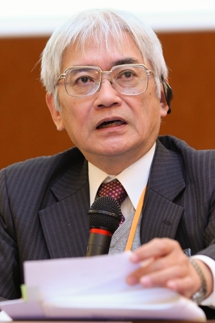 Prof. Satoru TANAKA
Prof. Satoru TANAKA- Prof. TANAKA: In pursuit of nuclear renaissance and nuclear non-proliferation and in consideration of the shift in the nuclear fuel supply system, the University of Tokyo team proposes a framework intended for Asia to maintain and enhance 3S activities with no discrimination among member states (see Fig. 1). This involves three types of framework (types A, B and C) and 12 requirements including those related to non-proliferation and the provision of nuclear fuel cycle services. Type A pursues only 3S enhancement in the region, type B supplies nuclear fuel and services at facilities owned by each state under an MNA agreement, and type C delegates the ownership of MNA facilities to a multilateral management organization.
Nuclear non-proliferation is ensured by complying with the nuclear non-proliferation requirements of the NSG guidelines and Section 123 of the U.S. Atomic Energy Act. By viewing a multilateral framework as a state that enters into an agreement with other nuclear supplier states, it is possible to avoid any disruption of supply or transfer of nuclear material caused by the right to consent stipulated in any existing bilateral nuclear cooperation agreement. It has been estimated that the total cost including transport costs in this framework is lower than that of a case where each state has its own nuclear fuel cycle facilities.
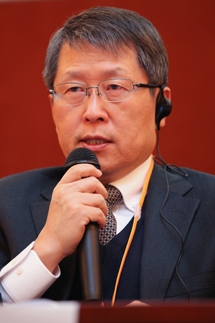 Prof. Il Soon HWANG
Prof. Il Soon HWANG- Prof. HWANG: We propose conducting a combination of an advanced aqueous process and an advanced pyroprocess as well as transmutation by an MNA (see Fig. 2). Solving the issue of accumulated spent fuel is a prime task in Asia. In the direct disposal of spent fuel, the radiation dose rate will have been reduced to allow human access hundreds of years from now. On the other hand, a large amount of plutonium will remain in the emplaced waste for about tens of thousands of years, and this can be a "plutonium mine." In the case of reprocessing, there is a time period during which proliferation resistance decreases due to separation of pure plutonium; this challenge, as pointed out in 2004 by the committee established by U.S. Department of Energy, must be supplemented by some institutional measures. Thereafter, repeated recycling in a fast reactor will improve nuclear proliferation resistance due to a radiation barrier created. If the issue of decreased proliferation resistance at the time of plutonium separation can be overcome by the multilateral approach and other institutional measures, reprocessing will have the advantage on direct disposal. Nevertheless, reprocessing does face some challenges including economic competitiveness, ensuring 3S during transportation, and high-level radioactive waste (HLW) disposal.
As for HLW, if the waste to be finally disposed of can be converted from high level to intermediate level by introducing a combination of an advanced aqueous process and an advanced pyroprocess as well as transmutation, the possibility of waste acceptance by the country of origin will increase. In addition, we can overcome the issue of economic competitiveness by increasing the scale of facilities. We should study the feasibility of the MNA by launching an Asia Pacific task force.
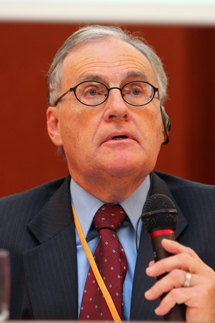 Mr. Stephen GOLDBERG
Mr. Stephen GOLDBERG- Mr. GOLDBERG: Our study focuses on an MNA for the back end as a business case and the involvement of the public and stakeholders in the MNA. Challenges in establishing a back-end MNA include developing a market where the supplier states and recipient states of nuclear fuel and services cooperate, understanding that back-end facilities are assets and not liabilities of states and communities, knowing how to control sensitive technologies, and striking a balance between cost and benefit.
We propose establishing a spent fuel temporary storage facility (see Fig. 3). This will be a regional facility that will store 10,000 metric tons of spent fuel for 100 years in view of economies of scale. It has flexibility to incorporate future technological advancements. The merits to the proposed facility include the capability for customer countries to mitigate spent fuel accumulation, infrastructure growth, job creation and a revenue stream for the host country, and enhanced proliferation resistance for the international community. There are also challenges to be addressed, which include public acceptance of the facility in the host country; long-term sustainability; legal issues such as rights, privileges and responsibilities; concern about restriction to the right of peaceful use of nuclear energy; sharing benefits between countries that opt for spent fuel direct disposal and those that opt for recycling; final disposal measures; sharing cost and benefit among participating countries; and the mechanisms of organizations and agreements.
Question 1: Significance of pursuing a multilateral cooperation framework in Asia
- Mr. NAOI: Because Asian states newly introducing nuclear reactors do not show much interest in spent fuel management, advanced nuclear states should take a lead in activating discussions. The MNA is effective also in terms of the enhancement of 3S.
- Dr. ZHANTIKIN: There is a big difference between the front-end and the back-end facilities of the nuclear fuel cycle in terms of public acceptance. No countries are willing to dispose of waste in their land-not in my backyard (NIMBY). Kazakhstan also prohibits by law any import of foreign nuclear waste. There should be a strict legal basis guaranteeing that temporary storage facilities of spent fuel will not become final repositories. Kazakhstan has experience in the management of spent FBR fuel, and this experience may be shared with other countries in the MNA spent fuel storage. Still, the public acceptance issue remains.
- Mr. GOLDBERG: If it is perceived that storage of spent fuel might lead to final disposal, it is difficult to gain public acceptance. We are working collaboratively with the Association for Regional and International Underground Storage (ARIUS) of Europe. People in the hosting community must first know the function of an MNA back-end facility.
Question 2: Possibility of multilateral cooperation on the back-end in Asia
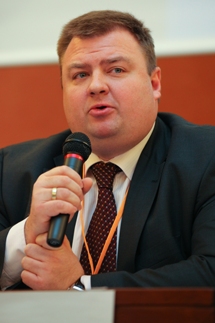 Mr. Gleb EFREMOV
Mr. Gleb EFREMOV- Mr. EFREMOV: I think that such cooperation is possible. The main issue, however, is which country can host spent fuel storage and disposal facilities. Russia, as with Kazakhstan, cannot accept spent fuel generated in foreign countries for final disposal purposes. We must assure the public that spent fuel is accepted only for temporary storage and will eventually be returned to the originating country.
* In discussing MNAs related to spent fuel, panelists confirmed the basic concept that the originating country of spent fuel is ultimately responsible for the spent fuel (Chairperson Kuno).
Question 3: Economic viability of a multilateral cooperation framework
- Prof. TANAKA: According to our estimation, the multilateral approach is not more costly than implementing a fuel cycle in each country. If infrastructures such as ports and transport routes are developed by multilateral cooperation, and smooth transportation is achieved, the economic merits of the framework will be enhanced.
- Prof. HWANG: Economic efficiency is not necessarily the prime factor for many of the Asian countries, which rely mostly on overseas countries for their energy and cannot depend on renewable energy as a prime solution. The life cycle and final state of the temporary storage of spent fuel are not yet clear. On a long-term basis, MNAs may overcome the issue of economic competitiveness.
Question 4: Solutions to transport issues
- Mr. EFREMOV: The Project Breakthrough of ROSATOM eliminates the need for transportation of nuclear material by locating nuclear fuel cycle facilities at a power station site. Currently, we are taking measures for nuclear material transport such as optimization of transport routes, utmost confidentiality of the type and quantity of material, and non-stop transportation in view of physical protection.
- Prof. TANAKA: It is important to ensure nuclear security during transport. Establishing an MNA is therefore beneficial in gaining cooperation from different countries. It is also necessary to design the MNA in consideration of security during nuclear material transport.
Question 5: Merits and demerits of multilateral cooperation frameworks as viewed from supplier and recipient states
- Mr. GOLDBERG: We can improve safety by the consolidated interim storage of spent fuel in the multilateral approach.
- Dr. ZHANTIKIN: The economy of transportation depends on the type of facility operated by the MNA. For example, if we produce value-added products such as fuel assemblies, there will be no significant problems because the transportation cost will be sufficiently lower than the cost of fuel assemblies.
[Question-and-answer session involving the audience]
- Question 1: For a multilateral cooperation framework to be effective, the nuclear policies of the member states must be consistent. Are states such as Japan that change their policy abruptly or back down from international commitments qualified to join multilateral cooperation?
- Mr. GOLDBERG: Participation in an MNA arrangement is voluntary, and any country can join or leave the arrangement. A country like Japan, having substantial nuclear assets and liabilities, needs to find a country that is willing to cooperate. Even if the Rokkasho Reprocessing Plant is operated to its maximum annual throughput of 800 metric tons, Japan still faces challenges left to be solved. For instance, Japan might want to cooperate with other nations based on multilateral approaches on the premise that policies may change after the passage of 10 years. Japan can therefore benefit from voluntary and flexible multilateral approaches.
- Prof. HWANG: There is instability in nuclear policy in almost every Asian country. Spent nuclear fuel is a common issue requiring a solution for all countries, and we should start working together with a small demonstration project.
- Question 2: The countries that can temporarily accept spent fuel as "treasure" rather than "waste" are Russia and France, which are capable of spent fuel recycling, and Japan is close to joining this group. The countries that can temporarily accept spent fuel containing plutonium without raising a nuclear proliferation issue are Russia and the United States. As a practical matter, how much do we have to pay to these countries in order to have one metric ton of spent fuel accepted?
- Mr. GOLDBERG: In the United States $28 billion has been collected into the Nuclear Waste fund. It looks like it's almost infinite. Our study indicates a cost of about 0.5 mills/kWh, which is not impractical for the users to bear.
If there is transmutation and other technological advancement, viewing spent fuel as treasure will provide an incentive to countries for hosting back-end facilities.
- Mr. GOLDBERG: In the United States $28 billion has been collected into the Nuclear Waste fund. It looks like it's almost infinite. Our study indicates a cost of about 0.5 mills/kWh, which is not impractical for the users to bear.
- Question 3: Although India is a non-NPT state which possess nuclear-weapons, the NSG granted an exemption and allowed nuclear exports to India. What is your view on this matter?
- Ms. SQUASSONI: The action that the United States took with respect to India was detrimental to efforts being made to harmonize the export controls of member states within the NSG.
- Question 4: According to Mr. Efremov's data, it is required that the sensitive technology exported should not be duplicated or improved by any recipient states. Isn't this requirement somewhat different from the requirement of the NSG guidelines calling for a black-box type transfer? It appears regulatory coordination between NSG member states is necessary. I would like to know about Russia's black-box measures. For example, how are the uranium enrichment facilities that Russia has exported to China being regulated?
- Mr. EFREMOV: The requirements on the transfer of sensitive technology as listed in my presentation material are only applicable to exports to non-nuclear weapons states, which do not include China. The Russian uranium enrichment technology is transferred to China under a black-box arrangement. The facilities are subject to IAEA safeguards, and Russia also conducts inspections in China so as to ensure that China will not replicate the Russian equipment and technology. Russia received an order for the fourth uranium enrichment facility in China last year. This clearly indicates that the Russian uranium enrichment technology is not being duplicated.
- Question 5: What is the incentive for states to participate in a multilateral cooperation framework? The general public may not be conscious of the difference between spent fuel and HLW.
- Prof. TANAKA: The incentive for joining a multilateral cooperation framework differs according to the situation of each state. We need to explain back-end related issues elaborately to build up trust between partner countries.
* Finally, Chairperson KUNO said that this topic would need extensive discussions to find a solution and suggested continuing further discussion in the future.
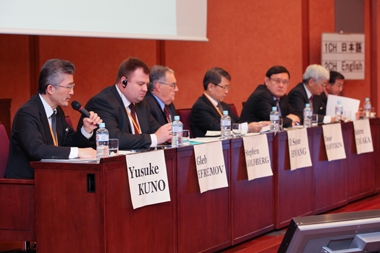
Closing Remarks
Prof. Satoru TANAKA, Professor, Department of Nuclear Engineering and Management, School of Engineering, The University of Tokyo
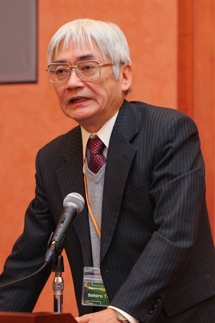 Prof. Satoru TANAKA
Prof. Satoru TANAKAI would like to thank all of you who have come from home and abroad to participate in the International Forum on Nuclear Energy, Nuclear Non-proliferation and Nuclear Security.
The circumstances of nuclear energy in Asia are changing and are about to shift to a next stage. In pursuing the peaceful use of nuclear energy, we must be fully aware of the importance of 3S and continue to make efforts to ensure 3S no matter which stage of the development in which each state is positioned.
The three organizations that host and co-host this Forum are research institutions and a university. I hope discussions initiated by such organizations will eventually be reflected in the policy of the Japanese government.
This Forum will be held again next year, and we would very much like to receive your suggestions for the topics to be discussed in the next year's Forum.
* This report contains the abstracts of the Keynote Speeches, the outlines of the Panel Discussions, and other materials presented at the Forum. The Secretariat of the Forum takes full responsibility for the wording and content of the Keynote Speech abstracts and Panel Discussion outlines.

